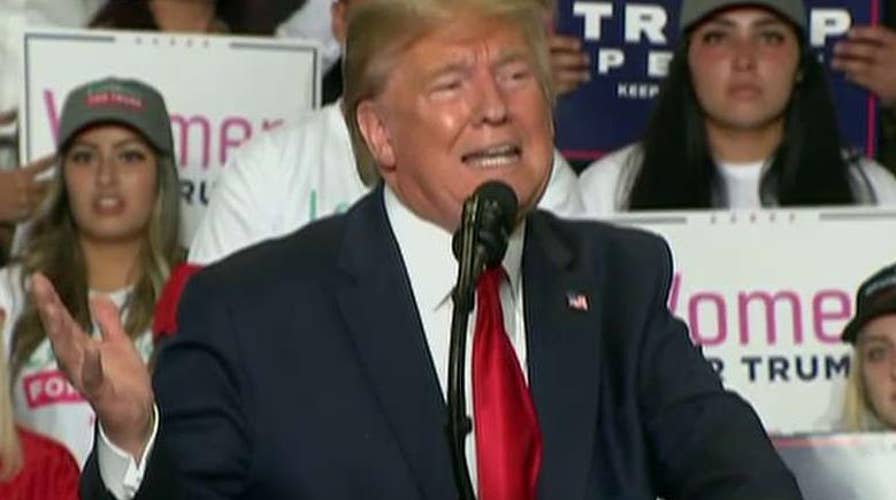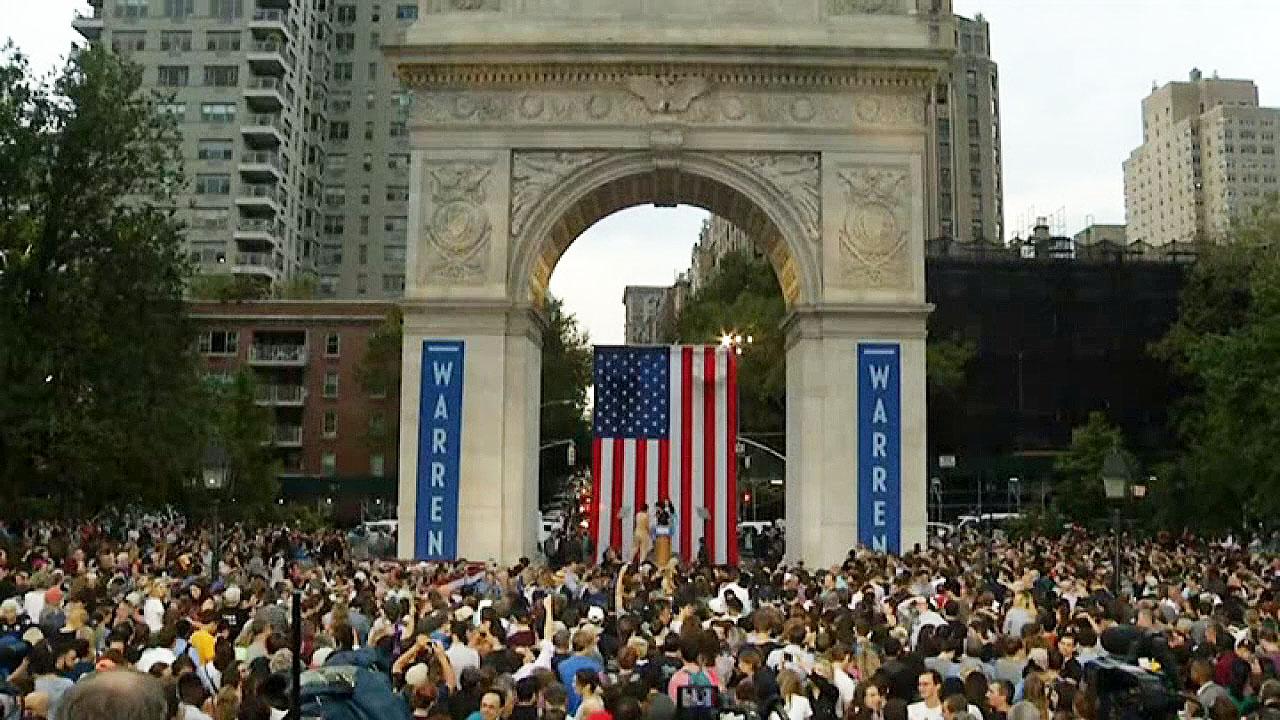Can Trump flip New Mexico from blue to red in 2020?
The Trump campaign says the key is winning over Hispanic voters in a state that hasn't been red since 2004.
President Trump and Democratic contender Elizabeth Warren hosted dueling rallies on Monday that attracted massive crowds, setting off a war of words between the two candidates that underscored rising national enthusiasm heading into the 2020 election.
Thousands of people packed under the marble arch of Manhattan's Washington Square Park to hear Warren, and her campaign estimated the attendance at 20,000-plus. Staffers also said that more than 5,000 people heard their candidate last week in Austin -- despite thunderstorms blowing in earlier in the day.
But speaking to reporters on Tuesday, Trump said of Warren's New York crowd, "Anybody can do that."
"No. 1, she didn't have 20,000 people," the president said. "And No. 2, I think anybody would get a good crowd there."
NYC Parks’ Assistant Commissioner for Communications, Crystal Howard, said in an interview with Breitbart News that the agency had issued Warren's campaign a permit for a rally of between 8,000 and 10,000 people -- and that the park's approximate total capacity is only 10,000.
TRUMP, AT FIERY NEW MEXICO RALLY, DEMANDS RESIGNATION OF NYT LEADERSHIP
Attendees at Trump's rally, meanwhile, took up every seat at the 7,500-capacity Santa Ana Star Center in suburban Albuquerque, with throngs gathered in an overflow area outside. People lined up 13 hours in advance of the rally, and traffic around the arena was snarled, according to local reports.
Local officials estimated that up to 15,000 people showed up to the rally in the Democratic-leaning state, which Trump lost by 8 points in the 2016 presidential election.
The president is trying to turn New Mexico red as part of an aggressive new campaign strategy. Trump's first visit to the Land of Enchantment as president drew visitors from Colorado, California and all parts of New Mexico, according to local media.
And Trump campaign officials said a campaign rally in nearby El Paso, Texas, last February was well attended by female and Hispanic voters and travelers from New Mexico, further suggesting that New Mexico is in play.
Trump is looking to find the next Wisconsin or Michigan — states that Democrats generally win in presidential elections but that can surprise under certain conditions, as they did in 2016. Also on the Trump team's shortlist: Nevada, New Hampshire and Minnesota.
Enthusiasm was apparent as the president touted New Mexico's economic successes and demanded the resignations of senior leadership at The New York Times following the paper's botched publication of a misleading accusation against Supreme Court Justice Brett Kavanaugh. Attendees enthusiastically chanted in response, "Four more years!"
“This is New Mexico. A lot of people in New Mexico really like Trump because he’s fighting for them,” an attendee told local station KRQE-13.
For Warren, attracting her own large crowd without the benefit of incumbency took special effort.

President Donald Trump arrives to speak at a campaign rally at the Santa Ana Star Center, Monday, Sept. 16, 2019, in Rio Rancho, N.M. (AP Photo/Evan Vucci)
The crowd was the product of a carefully planned, data-driven strategy to identify supporters, attract them to a rally and ultimately convert them into voters, a plan that goes well beyond producing a compelling scene for television.
In an era where campaigns increasingly try to leverage technology to tactical advantage, the attention to detail by Warren's team stood out among her Democratic rivals.
Like other candidates, her campaign invited past donors and other likely supporters who live nearby using email, mass text alerts and "peer-to-peer" text messages written by staffers before the event.
But that's just the start. At the venue itself, attendees must line up and check in using their phones, even if they've previously RSVP'd. When finished, they're sent a picture of the senator's Golden Retriever, Bailey, which they show at the door to be issued a red-dot sticker proving they've complied.
Warren's campaign spent months testing how best to collect information, trying out methods like different colors of paper signup sheets before settling on the current system since attendees get a doggie picture they're likely to enjoy.

Democratic presidential candidate U.S. Sen. Elizabeth Warren takes the stage before addressing supporters at a rally, Monday, Sept. 16, 2019, in New York. (AP Photo/Craig Ruttle)
"It's efficient but also fun," said Tessa Simonds, the Warren campaign's director of grassroots mobilization.
Warren has mastered the art of drawing thousands to her rallies, but, more importantly, those turning out are also a proxy for her recent rise in the polls. And the crowds have been building for weeks in places that have received relatively little attention from other candidates, including Seattle and Minneapolis.
In 2016, the enormous crowds who flocked to see Bernie Sanders were an early sign of the enthusiasm that would build around his campaign and lead him to nearly defeat Hillary Clinton for the Democratic nomination. This cycle, Sanders and other Democrats have also staged large rallies, but it is Warren who seems to hold the energy edge.
Trump's large crowds four years ago hinted at his coming Election Day upset. Similarly, Barack Obama was still largely unknown nationally when he launched his presidential bid in 2007 — yet demonstrated his early strength by drawing 20,000 at a Super Bowl Sunday rally in Delaware.
"When you get a big crowd and reporters are covering that and they're like, 'Wow, there's a lot of energy in the room,' ... that can absolutely get you free earned media," said Brendan Steinhauser, a Republican strategist and former top, conservative grassroots organizer. "And if we learned anything from 2016, earned media is really valuable and can — pardon the pun — trump the paid media."

Democratic presidential candidate U.S. Sen. Elizabeth Warren addresses supporters at a rally at Washington Square Park, Monday, Sept. 16, 2019, in New York. (AP Photo/Craig Ruttle)
At the same time, big crowds aren't everything. Many Democrats bitterly remember throngs watching Clinton, Bruce Springsteen and Jon Bon Jovi in front of Philadelphia's Independence Hall the night before Trump's 2016 victory. Democrat Walter Mondale attracted massive 1984 crowds in New York and Boston days before losing 49 out of 50 states (including New York and Massachusetts) to President Ronald Reagan.
That's because large rallies can show enthusiasm, but often aren't good indicators of whether support is growing beyond a candidate's established base. The people who show up to such events tend to be self-selecting.
PEOPLE TRAVEL FROM CALIFORNIA TO ATTEND TRUMP RALLY
"It's all reinforcing, the data, plus the visuals on TV feed more people in the crowds," said Joe Trippi, former campaign manager for Howard Dean, who organized early rallies large enough to briefly become a 2004 Democratic front-runner.
But when voting began, it became clear that the former Vermont governor was more effective at building ballyhooed crowds than winning votes.
"The issue is going to be, all that buzz on television and online, and the resources that it gets you, does that expand beyond that base support?" Trippi asked. "In the Dean campaign, it didn't. In Obama's it did."

Supporters of President Donald Trump cheer as he arrives to speak at a campaign rally at the Santa Ana Star Center, Monday, Sept. 16, 2019, in Rio Rancho, N.M. (AP Photo/Evan Vucci)
Judging crowd size is subjective, meanwhile, and can be so politically charged that police sometimes refuse to offer official estimates.
Warren's campaign says its crowd-size estimates partially come from staffers and volunteers using counting clickers to gauge the number of attendees.
The Warren campaign won't discuss its "targeting" of would-be supporters, nor would it touch analytical components like how many people it has on nationwide donor, volunteer or supporter lists. Aides concede they hope anyone invited to rallies will increase turnout by bringing friends, neighbors or relatives, but refuse to quantify how many new attendees such scenarios tend to generate.
Still, attracting the crowd is only the beginning.
Warren volunteers are trained as "canvassers," asking event attendees to rank their top three Democratic presidential primary choices. The campaign won't say if it treats people leaning toward other candidates differently from avowed Warren supporters.
Betting many will like what they see, Warren staffers follow up with rally-goers quickly, issuing text or email solicitations for donations or future volunteering — sometimes during or immediately after the event.
In states where Warren's campaign has lots of staffers, like Iowa, large teams of organizers can easily make follow-up contact. In other places, including Austin, staff based at Warren's Boston headquarters travel to the area beforehand, hoping to convert rally attendees into future volunteers.
Warren has become known for spending hours after each event taking "selfies" with attendees — and her staffers and volunteers work those lines, too, looking for future volunteers or people willing to try to recruit friends and neighbors to be supporters.
CLICK HERE TO GET THE FOX NEWS APP
Trump generally keeps a tighter schedule at his rallies. The president stayed in New Mexico on Monday night, then flew to the San Francisco Bay area on Tuesday for a luncheon fundraiser. He is expected to attend a fundraising dinner in the evening in Beverly Hills at the home of real estate developer Geoffrey Palmer.
He has two more fundraisers planned in Los Angeles and San Diego on Wednesday.
The fundraisers in left-wing strongholds will benefit Trump Victory, the joint entity that funds Trump's reelection campaign and the Republican National Committee.
Fox News' Alex Pappas and The Associated Press contributed to this report.






